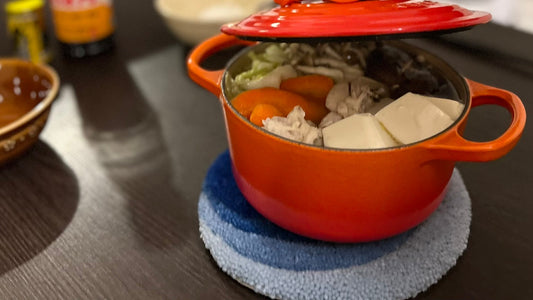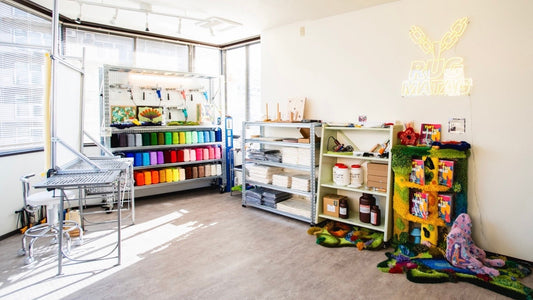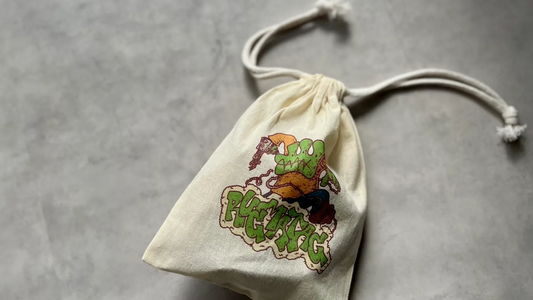
Comparative verification of yarn
Hello. We are Tufting studio & shop RUGMATAG, a tufting workshop and equipment/materials specialist store in Morinomiya, Osaka .
In this blog, I've compared the amount of yarn used, the texture of the finished product, etc. when making a rug with the exact same design using yarn for tufting (acrylic/wool) and acrylic yarn for crafts.
I hope this will be helpful for anyone who has questions such as, "I'm not really sure what the difference in the finished product is," or "How much yarn will be used in the end?"
The yarn used this time is
- Medium-weight acrylic yarn for handicrafts that is commonly sold
・We sell Miyoshi Rugs MB210 HIGH QUALIRY ACYRIC YARN (Acrylic yarn for tufting)
・RUGMATAG WOOLYARN (wool yarn for tufting)
There are three types:
Pre-production preparation
This time we will be comparing the same designs, the same spacing and the same finishing methods, with only the yarn being changed.

The design will be a 25cm x 25cm square with each half being a different color.

Measure the weight of the yarn before starting production.
This time, we will use two strands of acrylic yarn for crafts and two strands of wool yarn for tufting, and five strands of acrylic yarn for tufting.

I made sure to transfer all the drafts to the same size of 25cm x 25cm.
Production

For this production, I used the AK-1 in the 17mm setting.
To avoid any differences, all three were produced using the same gun and shooting method.
Measuring yarn consumption after production
The remaining amount of yarn

Amount of yarn consumed

After making the yarn, I weighed the yarn and calculated the amount used, and got the following results. The amount of yarn used for tufting was almost the same, but the amount of yarn used for handicrafts was about 50g less.
Finishing

This time, the lining mesh + The lining is finished with a combination of tufting backing agents (containing anti-mite ingredients) .
I applied it evenly to avoid any discrepancies.

This is the weight of the rug with the lining cut and the surface untreated.
The adhesive and lining added about 40 to 50g.

Smooth out the surface and it's done.
We used a trimmer guide to smooth the surface to the same thickness (18mm) and size, and then used a trimmer to round the edges.
finish
Acrylic yarn for crafts is lighter than the other two types. It has a soft texture and sinks when pressed with your fingers. It doesn't have much of a grainy feel.
Acrylic yarn for tufting is made of 5 strands, so it is fine and suitable for delicate expressions such as gradation. It has a soft texture like acrylic yarn for handicrafts, but it has a soft cushioning effect. If it is the same size, the amount used is almost the same as wool yarn.
Wool yarn for tufting has a more solid finish than acrylic yarn. The yarn is firm and does not sink much when pressed with your fingers, leaving little marks. Because it is a two-strand yarn, it is not suitable for expressing gradations, but it makes carving clearer and the boundaries between colors clearer. It is also suitable for designs where you want to create clear lines.
* Regarding durability
This time, we were only comparing the production, so we were unable to compare durability, but the yarn for tufting seems sturdy, as both are made for rugs. As for the yarn for handicrafts, it seems like it will lose its shape easily if stepped on, so I felt it would be more suitable for wall hangings.
Generally speaking Wool yarn is said to be highly durable, and is used in luxury rugs. In addition, wool yarn is an animal fiber, so it is difficult to burn and has excellent temperature and humidity regulation, making it a practical material.
summary
What do you think? This time, we tried to compare three types of yarn that are commonly used for tufting by making the same design to see how the consumption, finish, and texture differ. We hope this comparison will be helpful when choosing yarn that suits the design and purpose of the rug you want to make.
About new information notifications
Thank you for reading to the end. RUGMATAG plans to continue posting various articles about tufting. We plan to regularly announce the latest information on Instagram , Twitter , our official LINE account , and our email newsletter (see below). If you are interested, please follow us on social media, add us as a friend on our official LINE account, and subscribe to our email newsletter.


















